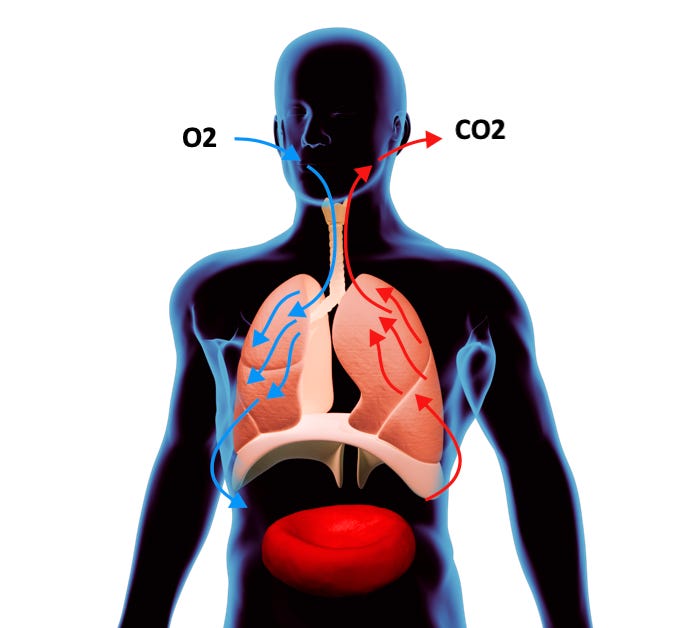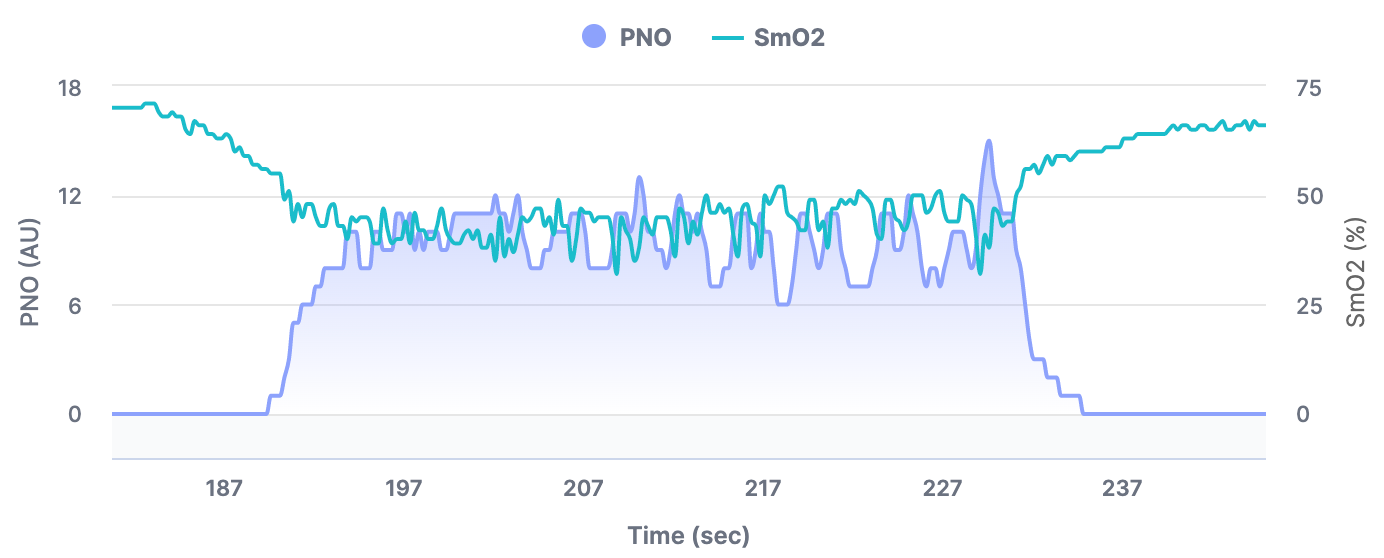The Two Gas Respiratory Cycle
Nitric Oxide is one of the most important molecules for promoting health, fitness, and performance, yet few people are aware of its role in the body because our traditional understanding of the respiratory cycle is incomplete. We've all been taught the classic view of the respiratory cycle. We breathe oxygen in, and we breathe carbon dioxide out.
This classic depicts blood as a passive substance that simply carries oxygen and carbon dioxide to and from tissues respectively, while the heart is the primary regulator of systemic blood flow. After blood leaves the heart it flows into large arteries that fan out into progressively smaller arteries that eventually reach individual organs and tissues. As hemoglobin packed into red blood cells travels through the body it flips back and forth between two distinct shapes. When hemoglobin is loaded with oxygen it takes on shape A, and after it releases oxygen it changes to shape B, then picks up carbon dioxide. In other words, hemoglobin’s shape changes depending on its oxygen supply.
The Role of Nitric Oxide In Respiration
The classic two-gas respiratory cycle accounts for oxygen and carbon dioxide, but there's a third lesser known gas, called nitric oxide, that completes the cycle. Ordinary nitric oxide is produced in the inner lining of blood vessels and is scavenged from tissues by hemoglobin as the red blood cells travel through the tissue's vasculature. When ordinary nitric oxide is picked up by hemoglobin, it binds to the heme-iron center in the hemoglobin molecule.
On the way back to the lungs the red blood cells, which have already delivered oxygen to the tissues, are loaded with carbon dioxide and nitric oxide. Once the red blood cells enter the lungs they release carbon dioxide, which is expelled as a waste product. Then hemoglobin picks up oxygen in the pulmonary capillaries and the nitric oxide moves from the hem- iron in hemoglobin to the 93-cysteine amino acid site, forming S-nitrosohemoglobin, or SNO-Hb for short. Importantly, SNO-Hb is the bioactive form of Nitric oxide that controls blood flow to tissues. After leaving the lungs, many red blood cells are packed with hemoglobin carrying oxygen and SNO-Hb. They then travel to the heart and are pumped out to the rest of the body to nourish tissues including the brain, heart, and exercising muscles.
When oxygen and SNO-Hb laden red blood cells reach the microvascular arterioles and capillaries of the tissues, such as muscle, hemoglobin senses how much oxygen is present. If the oxygen level in the tissue is low, hemoglobin responds by changing its shape, causing oxygen and SNO-Hb to be released. Oxygen nourishes the surrounding tissues whereas SNO-Hb signals for the blood vessels to widen, resulting in even greater blood flow and oxygen delivery to the tissues. When oxygen levels in the tissue are high, hemoglobin doesn’t change its shape and oxygen and SNO-Hb are not released. This system makes sense when you consider the need to regulate blood flow at the level of individual tissues. For example, when you exercise you must deliver more blood to working muscles to nourish them with oxygen. But when you stop exercising you want to slow blood flow back down. Each tissue has its own blood flow requirements and hemoglobin regulates blood flow to individual tissues on an as needed basis.
The Role Of Active Nitric Oxide In Health & Performance
Doctors have long known that there is a significant disconnect between the amount of oxygen carried in the blood and the amount of oxygen delivered to the tissues, such as exercising muscles. Therefore, the current generation of wearables that measure blood O2 levels lacks a key ingredient for giving you a better biomarker of health or fitness. While the aforementioned devices tell you how much oxygen is carried in the blood, they still leave you in the dark as to how much oxygen is delivered to tissues.
Active nitric oxide increases blood flow to tissues; without active nitric oxide the ability to nourish tissues with oxygen is significantly impaired. Thus, by measuring both active nitric oxide levels and the amount of oxygen in muscles, NNOXX provides a powerful health and fitness index.
It’s well known that consistent and routine exercise can improve active nitric oxide levels over time. But the type, intensity, and duration of exercise that best increases those levels will vary from person to person. Traditional measurements of active nitric oxide require a blood sample from the macro-vasculature, as well as complex laboratory procedures, and cannot directly predict oxygen delivery to tissues. As a result, scientists have previously been limited in their ability to discover optimal and individualized methods to increase active nitric oxide (SNO-Hb) levels in order to improve brain and cardiovascular health, fitness, and exercise performance. That is, until now.
NNOXX is redefining human health and performance with the world’s first and only non-invasive active nitric oxide activity measurement. NNOXX combines state-of-the-art biosensors and AI-powered analytics to help people boost their active nitric oxide levels through exercise. By doing so, exercisers can increase blood flow to their brain, heart, and working muscles.
A Special Offer For My Readers:
The NNOXX team is excited to share what we've developed with you and as a bonus offer we’re giving away my ebooks for free! This ebook encompasses everything I’ve learned about the science and practice of human performance over the past twelve years and I can’t wait to share it with you.








Hey, Evan, thanks for the article! Great content as always! I'm not finding your ebook Paradigm Shift to download it. Could you help this young man here to find it?
Hey Evan. Does supplementation with L-arginine or L-citrulline boost nitric oxide levels to truly enhance physical performance?